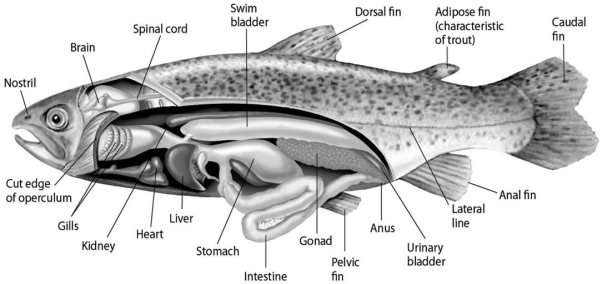Multiple Choice
Please use the following information to answer the questions below.
 Figure 27.2
Figure 27.2
Fishes that have swim bladders can regulate their density and thus their buoyancy.There are two types of swim bladder: physostomous and physoclistous.The ancestral version is the physostomous version,in which the swim bladder is connected to the esophagus via a short tube (Figure 27.2) .The fish fills this version by swimming to the surface,taking gulps of air,and directing them into the swim bladder.Air is removed from this version by "belching." The physoclistous version is more derived and has lost its connection to the esophagus.Instead,gas enters and leaves the swim bladder via special circulatory mechanisms within the wall of the swim bladder.
-The presence of a swim bladder allows the typical ray-finned fish to stop swimming and still
A) effectively circulate its blood.
B) be highly maneuverable.
C) use its swim bladder as a respiratory organ.
D) not sink.
Correct Answer:

Verified
Correct Answer:
Verified
Q43: Had the teacher wanted to point out
Q44: Which of the following clades contains the
Q45: During chordate evolution,what is the sequence (from
Q46: Which of the following genetic processes may
Q47: Which clade does not include humans?<br>A)synapsids<br>B)lobe-fins<br>C)lophotrochozoans<br>D)tetrapods
Q49: What do all craniates have that earlier
Q50: Which tree(s)has (have)been created by emphasizing the
Q51: On the basis of the information in
Q53: Which of these might have been observed
Q88: Which of the following are the only